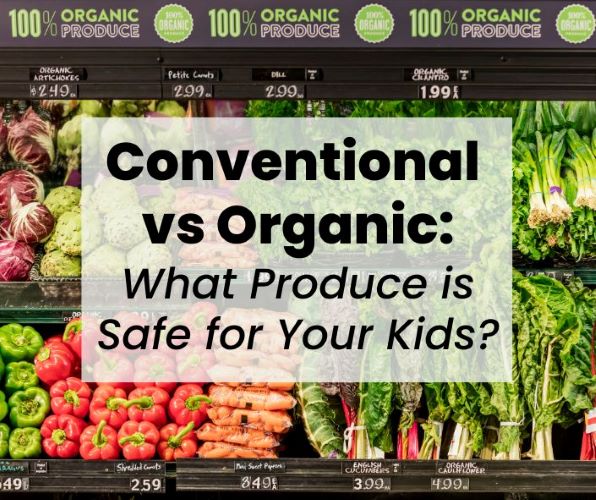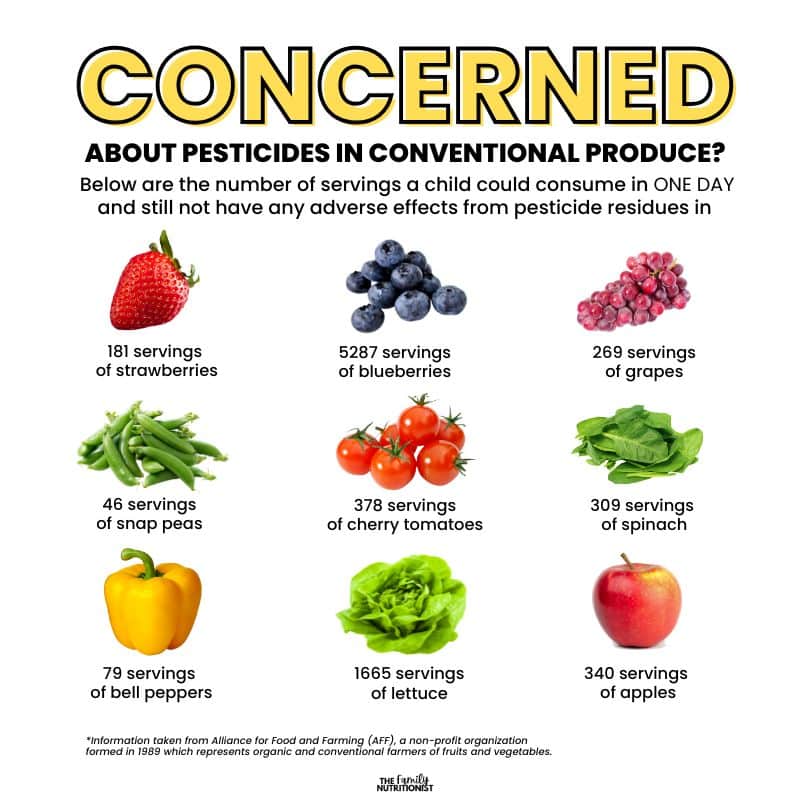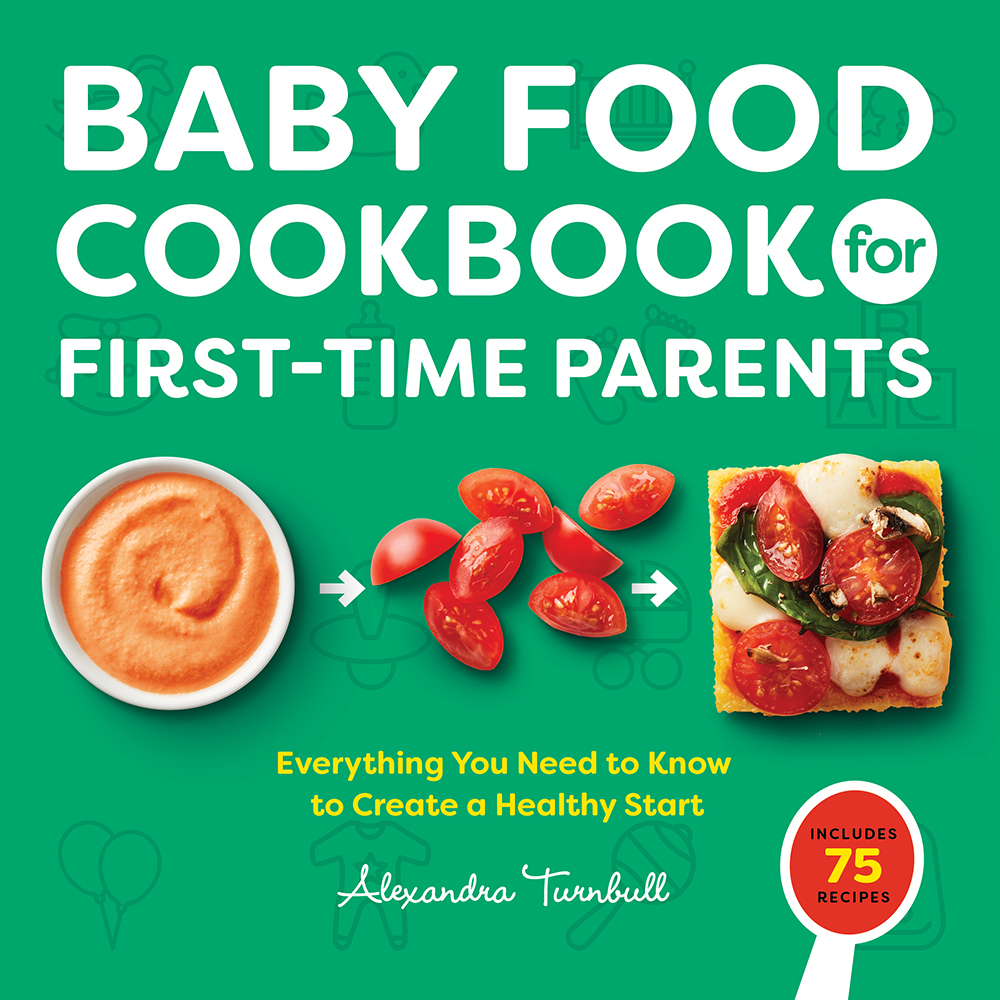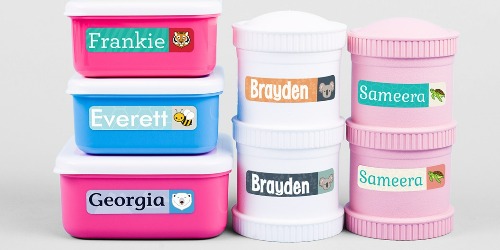As parents, we’re often faced with countless choices in the grocery aisle, and when it comes to fruits and vegetables, a common question is whether to choose organic or conventional produce for our kids.
Both organic and conventional produce offer nutritional benefits, but concerns around pesticide exposure can make the choice feel daunting. Here, I’ll break down what research says about the safety of both types of produce, so you can feel informed when filling your cart.
Table of Contents
Understanding Organic vs. Conventional Produce

A common misconception is that organic farming doesn’t use pesticides however, this is false. Both forms of farming utilize pesticides. The difference may be in what the pesticides are derived from.
Organic Produce: Organic farming practices aim to reduce the use of synthetic pesticides and fertilizers, relying on natural alternatives like crop rotation and composting. The USDA organic certification ensures that organic produce meets strict standards.
Conventional Produce: Conventional farming uses a broader range of pesticides and fertilizers, including synthetic chemicals, to maximize crop yield and pest control. These pesticides must meet safety regulations set by agencies like the Environmental Protection Agency (EPA).
Are Pesticides on Conventional Produce a Risk?
The main concern with conventional produce is pesticide residue. However, most pesticide levels in conventional produce are well below the EPA’s established safety thresholds and the EPA has an extensive process for assessing the risk of pesticide exposure.
A 2019 systematic review published in Nutrients examined studies comparing health outcomes of people who consume organic vs. conventional produce. The review concluded that both types of produce can be safe, as long as pesticide residues are within regulated limits. Regular washing of fruits and vegetables also reduces pesticide residues, minimizing risk further.
The USDA’s Pesticide Data Program (PDP), which tests produce for pesticide residues annually, has consistently found that the vast majority of produce (both domestic and imported) falls well within safety standards. The EPA also states that the risks from low-level pesticide exposure in food are minimal, and the agency regularly updates its guidelines to reflect new research on health and environmental impacts.
What is Considered “Safe” Pesticide Levels?
What’s important to remember is that anything in excess isn’t the best for us, including something our body needs to live – water. So yes, while exposure to pesticides is important to consider, it’s also crucial to understand how much you or your child would need to consume in order to pose a risk.
Here’s a pesticide calculator from the Alliance of Food and Farming, a non-profit that supports both organic and conventional farmers. Check out their Perspective on Pesticide Residues in Fruits and Vegetables for even more information.
For instance, a child would need to consume 181 strawberries in one day without any effect even if the strawberries have the highest pesticide residue recorded for strawberries by the USDA. This is an important perspective to consider when concerned about the safety of the food you feed your children.

Kids and Pesticides: What Does the Research Say?
Studies on pesticide exposure in children often make headlines, but it’s essential to look at what the research reveals. Long-term studies have shown no evidence that eating conventional produce at normal levels increases the risk of disease in children. According to the American Academy of Pediatrics, the health benefits of eating a variety of fruits and vegetables outweigh any potential risks from pesticide residues. By focusing on a well-balanced diet, parents can rest assured that conventional produce supports growth and development.
Do Organic Foods Have More Nutritional Benefits?
When it comes to nutrient density, research has shown mixed results. A 2014 meta-analysis in The British Journal of Nutrition indicated that organic produce might have higher levels of certain antioxidants. However, other studies, including a 2012 Stanford University review, suggest that the nutritional differences are minor and do not significantly impact overall health.
For parents, this means that both organic and conventional produce offer important nutrients, and the choice may come down to budget or personal preference.
Benefits of Conventional Produce
For families on a budget, conventional produce offers an affordable way to provide essential nutrients without sacrificing health. Here are a few reasons why conventional produce is a smart choice:
- Cost-Effective Nutrition: Conventional produce is often significantly less expensive than organic, making it accessible for families who want to maximize their food budget. While this isn’t always the case, Consumer Reports conducted a unique price study and found that organic produce was 47% more expensive. The nutrients in fruits and vegetables—like fiber, vitamins, and minerals—are just as valuable in conventional produce as in organic, so families don’t miss out on the health benefits.
- Safe, Regulated Pesticide Levels: Conventional produce must meet strict safety standards set by regulatory agencies like the EPA. Studies, including those by the USDA’s Pesticide Data Program, consistently find that pesticide residues on conventional produce are within safe limits, especially after washing.
- Encourages a Plant-Rich Diet: Eating a variety of fruits and vegetables is the cornerstone of a healthy diet. Sticking to a budget by choosing conventional produce means families can include more diversity in their meals, getting the benefits of a wide range of vitamins and antioxidants that support overall health.
- Washing Reduces Residues: Simple steps like rinsing produce under running water can further reduce pesticide residues on conventional produce, making it an even safer option.
For families, the priority should be ensuring children eat plenty of fruits and vegetables rather than worrying about organic vs. conventional. Conventional produce provides a nutritious and budget-friendly option, helping families support their kids’ health without added financial strain.
Tips for Reducing Residues (Without Breaking the Bank)
While conventional produce is safe, here are a few simple steps to further reduce any residual pesticides without opting for organic:
- Rinse with Water: Washing produce under running water removes a large percentage of residues. Avoid soaps or special washes—plain water does the job.
- Peel When Possible: For produce like apples or cucumbers, peeling the skin can reduce residues. However it also reduces the fiber.
- Diversify the Diet: Providing a variety of fruits and vegetables means your child’s exposure to any one type of pesticide residue is limited.
Final Verdict: Safe Choices for Kids
While minimizing exposure to pesticides is important, both conventional and organic produce are safe for children when managed appropriately. For families, the key takeaway is that eating a diverse array of fruits and vegetables that fit within your budget, no matter how they’re grown, supports a healthy diet.
By staying informed and understanding that both options can be safe and nutritious, you can confidently make the best choice for your family’s health and budget.





